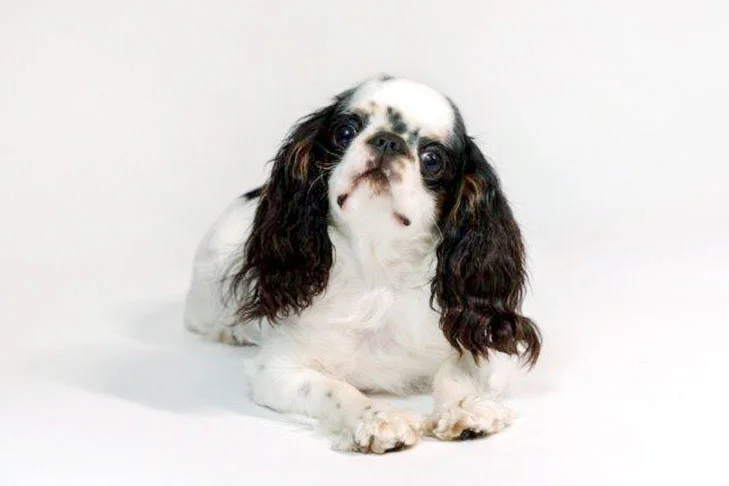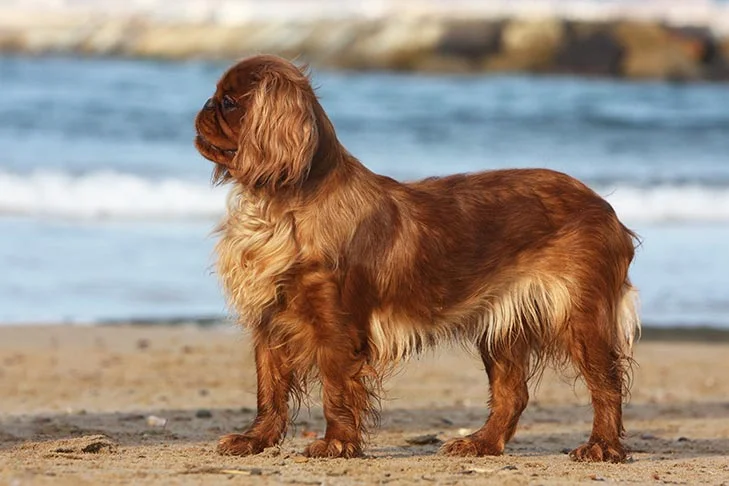English Toy Spaniel
intelligent / playful / gentle
Toy Group >>
Average sizes and life
expectancy of the breed.
Height
9-10 inches
Weight
8-14 pounds
Life Expectancy
10-12 years
Breed Traits & Characteristics
About the Breed
The joyful English Toy Spaniel was bred to be a king’s pet. However, ETS are spaniels first and lapdogs second. Underneath the ostentatious façade pulses the heart of a true dog—bright, caring, and eager to please.
A square, snub-nosed toy with the ETS logo weighs no more than 14 pounds. A well-known breed characteristic is the huge, conical head with its long, luxuriant ears, dark, melting eyes, and full cheeks. The extravagant coat is available in four different colors, each with its own official name: solid red (Ruby), white, black, and tan, and red and white (Blenheim) The ETS developed the personality of its aristocratic owners, like many other toy breeds that were maintained by royals. They have a tendency to be arrogant, stubborn, and very picky about who they choose as friends. They are affectionate at home and joyful and inquisitive during play when they are with their favorite humans.

What To Expect When Caring For a English Toy Spaniel
Owning a dog is not just a privilege; it’s a responsibility. They depend on us for, at minimum, food and shelter, and deserve much more. When you take a dog into your life, you need to understand the commitment that dog ownership entails.
 Health
Health
Although English Toy Spaniels are typically healthy dogs, there are a few health issues and genetic screening issues that are particular to the breed, such as eye issues, cardiac issues, and luxating patellas. Breed health and the maintenance of the breed's distinctive characteristics are the goals of committed breeders who frequently assess their breeding stock and collaborate with one another. The teeth should be brushed frequently with a toothpaste made for dogs, and the English Toy Spaniel's ears should be constantly examined for indications of infection. To ensure the dog has a long and healthy life, regular visits to the vet for checks and parasite management are recommended.
Recommended Health Tests From the National Breed Club:
- Cardiac Exam
- Ophthalmologist Evaluation
 Grooming
Grooming
Brushing with a pin brush or soft bristle brush is recommended at least twice a week for the English Toy Spaniel's long, wavy, silky, and abundant coat. To carefully massage through places where tangles may be forming, a long-toothed metal dog comb can be useful. Tangles and mats are irritating for your dog and can lead to skin issues if not addressed to. Your English Toy Spaniel's appearance can be maintained with regular trimming around the face, feet, and other places. A bath with a light shampoo made for dogs every four to six weeks will help to maintain the English Toy's coat and skin clean and healthy. The nails should be cut once a month. Checking the dog during a grooming session is a fantastic opportunity to look for any new lumps or skin issues, as well as to ensure that the eyes and ears are healthy and problem-free.
 Exercise
Exercise
When exercising outside, English Toy Spaniels are alert, playful, and enthusiastic; nevertheless, at home, they are staid and polite. They are calm canines that make great companions for city residents in studio apartments who can take the dogs on daily leash walks. The ETS is a short-faced breed that cannot handle extreme heat and should not be left outside on hot or muggy days.
 Training
Training
The breed, commonly referred to as the "Charlie," is calm, content, and dedicated to his owners. He has a kind heart and is meticulous about his appearance. The breed has kept characteristics from his sporting forebears and is regarded to be a good tiny hunting spaniel, despite serving as a companion to owners who want a happy, caring pet. They are intelligent but can be difficult to train; the secret to success is patience, perseverance, and a kind, upbeat attitude. Never use harsh techniques on this empathetic, loyal breed. Charlie will develop into a well-adjusted, well-mannered companion with early socialization and puppy training lessons, which are advised.
 Nutrition
Nutrition
The English Toy Spaniel should be fed a premium dog food that is good for small or toy breeds and suitable for the dog's age (puppy, adult, or senior). Watch your dog's calorie intake and weight level because certain dogs are prone to obesity. Treats can be a valuable training tool, but offering them in excess might lead to obesity. Give table scraps sparingly, if at all, and steer clear of cooked bones and too fatty foods. Discover which foods fit the bill for canine consumption and which don't. If you have any worries about your dog's weight or diet, consult your veterinarian.
History
Famously, toy spaniels are linked to the “Merry Monarchs” of the 1600s, Britain’s Charles I and II, whose active small dogs came to represent the House of Stuart. Toy spaniels were the only dogs permitted in the House of Parliament during the reign of Charles II, who was possibly Britain’s most dog-friendly king prior to Victoria.
The history of toy spaniels in Europe and Britain is unknown. According to some authorities, miniature spaniels were first introduced to Europe from China or Japan in the past. Others contend that toy spaniels were sent from Spain, the reputed birthplace of the spaniel breeds, to Asia, where Asian breeders improved the canines before exporting them to England, Italy, and other European countries.
Toy-sized versions of the sporting-spaniel breeds that the aristocrats of Renaissance England preferred were the in-vogue canines. A tiny spaniel accompanied Mary Queen of Scots to her beheading in 1587; they were known as “the Spaniel Gentle” or “the Comforter” in Shakespeare’s day. By the time Charles II came to power in 1665, some British aristocratic families had adopted toy spaniels as their mascots.
The English Toy Spaniel, also known as King Charles Spaniel in the United Kingdom, originated during the Victorian era when British toy spaniels were bred with Asian toys, most likely Pugs and Japanese Chin. Compared to toy spaniels from Charles’s era, this one featured a flatter face and a domed head. The classic toy spaniel of the Restoration era was practically dead as the new kind, the EST, quickly gained dominance. In the 1920s, the vintage toy was brought back to life, and American collectors now refer to it as the Cavalier King Charles Spaniel.



